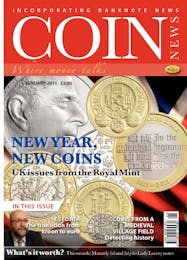No secret, no exception
HAVE made no secret of my support for the Royal Mint over the years—maybe the “year sets” aren’t great on the secondary market and, yes, it is a great shame when someone believes that their “nest egg” collection of Uncirculated coins and base metal commemoratives will net them a fortune when they come to sell. The arguments for and against “new issues” and their so-called investment potential have raged for years and it isn’t for me to go over them again here. No, my support for the Royal Mint comes because I believe that they are the single most important body in this country when it comes to encouraging the general public to view coins as something to be collected rather than just spent.
Without the thought that goes into our coins’ designs, without the excellent designers themselves and without their desire to make excellent products, our coinage would comprise bland utilitarian discs suitable for transactions and nothing else. Numismatics, as we all know, is as much about the aesthetics of the coins as their rarity and we all appreciate the beauty of some of the gems from the past: the Athenian Owls, the Three Graces, the Gothic Florins, etc., etc. I believe the Royal Mint carries on the tradition of beauty on coins very well indeed. Certainly some of their designs have been, shall we say, “challenging” in recent years. Some have been unusual, some down right odd (my favourite “odd” design has to be Roger Bannister’s legs on the 50p), but rarely are they dull. This year is no exception as you can see from this month’s front cover. Not only do we have the next two in the £1 cities series: Edinburgh and Cardiff (has anyone come across the London or Belfast designs yet? I have yet to see them in change), but we also have two artfully crafted £2 coins—one depicting the 500th anniversary of the launch, and sinking, of Henry VIII’s flagship the Mary Rose (with typical British timing the Mary Rose herself will not actually be on display throughout the entire year as a new museum being built to house her won’t be ready until 2012!) and the second depicting the 400th anniversary of the King James Bible.
There will also be a very modern-looking 50p (as well of course as the plethora of Olympic 50 pences) that shows the work of the World Wide Fund For Nature (WWF) and a particularly striking £5 Crown to celebrate the 90th Birthday of HRH Prince Philip. Added to that we are confidently expecting there to be a Royal Wedding Crown to celebrate the marriage of Catherine Middleton and HRH Prince William on April 29 (at present the Royal Mint has only announced that there is to be an Alderney Crown to celebrate the Engagement. May I respectfully suggest, with no ill-will directed at Alderney, that this is not enough to celebrate the wedding of our future King and that as other countries will undoubtedly be producing commemoratives, the Royal Mint really should look at striking something a little more high profile). Of course, not all of these designs will appeal to everyone, but there is no denying they are impressive—the Prince Philip Crown in particular is more art medal than coin and regardless of your views on the monarchy in general or his Royal Highness I defy you not to appreciate the design for its numismatic qualities!
Of course the Mint will always have its detractors. There will always be those who criticise its work, believe it shouldn’t be in the marketing game and should simply produce coins for us to use to buy things. But to want that is to miss one very important point. The vast majority of the Great British public will never, ever, come across any coins other than the ones they use in shops . . . they won’t go to coin fairs on a whim and won’t bother checking antique shops just for fun. They will only ever come to appreciate coins as more than mere spending tokens by learning to like the coins they handle every day. By learning about the coins they have in their purses and pockets and by seeing them as more than a means with which to buy things, they can and do become bona fide collectors. Most of us started that way: by looking out for rarities and unusual coins in our pre-decimal change. There are no rare dates any more, there are no Victorian shillings to be scooped up and squirrelled away as we used to—there is only the aesthetics of coins, their beauty, their design. These are the things that get people hooked, and with that in mind I think the Royal Mint do a very good job indeed. This year is no exception.

Archives
-
2024 (15 articles)
-
2023 (55 articles)
-
2022 (44 articles)
-
2021 (59 articles)
-
2020 (80 articles)
-
2019 (50 articles)
-
2018 (49 articles)
-
2017 (46 articles)
-
2016 (54 articles)
-
2015 (44 articles)
-
2014 (62 articles)
-
2013 (75 articles)
-
2012 (74 articles)
-
2011 (81 articles)
-
2010 (131 articles)
-
2009 (91 articles)
-
2008 (89 articles)
-
2007 (75 articles)
-
2006 (76 articles)
-
2005 (19 articles)
-
2004 (11 articles)
-
2003 (23 articles)
-
2002 (16 articles)
-
2001 (11 articles)









